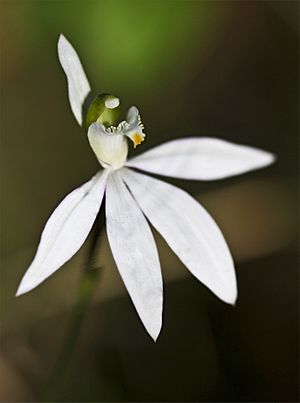White caladenia facts for kids
Quick facts for kids White caladenia |
|
|---|---|
 |
|
| Scientific classification | |
| Genus: |
Caladenia
|
| Species: |
catenata
|
| Synonyms | |
|
|
Caladenia catenata, often called the white caladenia, white fingers, or lady's fingers, is a type of plant in the orchid family. It grows naturally only in New South Wales, Queensland, and Victoria in Australia. This ground orchid has one hairy leaf. It also has one or two white flowers, sometimes pink, on a thin stem. The stem has only a few hairs. This orchid looks a bit like Caladenia carnea. However, Caladenia catenata does not have the red and white stripes on its labellum (the orchid's special lip petal).
Contents
What Does the White Caladenia Look Like?
Caladenia catenata is a plant that grows from the ground. It is a perennial plant, meaning it lives for more than two years. It is also deciduous, so its leaves die back each year. This plant has an underground tuber, which is like a small storage root. It has one leaf that is about 6 to 14 centimeters (2.4 to 5.5 inches) long. This leaf is thin, about 3 to 4 millimeters (0.12 to 0.16 inches) wide, and has a few hairs.
Flowers of the White Caladenia
The plant usually has one or two flowers. These flowers grow on a thin stem that is about 10 to 30 centimeters (3.9 to 11.8 inches) tall. This stem also has a few hairs. The sepals and petals of the flower are shiny white. Sometimes, they can be pink. They have a few hairs on the outside, especially near the bottom.
The top sepal, called the dorsal sepal, is long and narrow. It stands up straight or bends slightly forward. It is about 15 to 22 millimeters (0.59 to 0.87 inches) long. The side sepals and other petals are about the same length. They spread out from the flower.
The labellum (the orchid's special lip petal) is white or pinkish. It has a yellow-orange tip. This labellum is about 8 to 10 millimeters (0.31 to 0.39 inches) long. When flattened, it is about 6 to 18 millimeters (0.24 to 0.71 inches) wide. It has three parts, called lobes.
Labellum Details
The middle lobe of the labellum is shaped like a triangle. It is longer than the side lobes. This middle lobe curves downwards and has small, finger-like teeth along its edges. The side lobes are narrow. They might have a few teeth near their ends.
In the center of the middle lobe, there are two rows of small, club-shaped bumps. These bumps are called calli. They are yellow or white. These calli only go as far forward as the front of the side lobes.
When Does it Bloom?
White caladenia flowers bloom from August to November. They tend to flower earlier in New South Wales than in Victoria.
How it Compares to Other Orchids
This orchid is similar to C. carnea, also known as the Pink Fingers orchid. However, C. catenata does not have the red and white stripes on its labellum that C. carnea has. In some areas, these two types of orchids can even mix and create hybrid plants.
Naming the White Caladenia
The first official description of this orchid was made in 1805. It was described by a person named James Edward Smith. He named it Arethusa catenata in his book, Exotic Botany.
Later, in 1917, George Druce changed the name. He renamed it Caladenia catenata. He published this change in a report called The Botanical Exchange Club and Society of the British Isles Report for 1916, Supplement 2.
What Does "Catenata" Mean?
The second part of the name, catenata, is a Latin word. It means "chained." When James Edward Smith first described the orchid, he mentioned that its labellum had "chain-like glands." This is why he chose the name catenata.
Where Does the White Caladenia Live?
The white caladenia is not very common in Victoria. There, it grows in small groups in forests and woodlands. These areas are mostly east of Melbourne.
It is more common in New South Wales. In this state, it usually grows in sandy soil. You can find it in coastal forests and shrublands. It is probably the most common Caladenia orchid found around the Sydney area.

